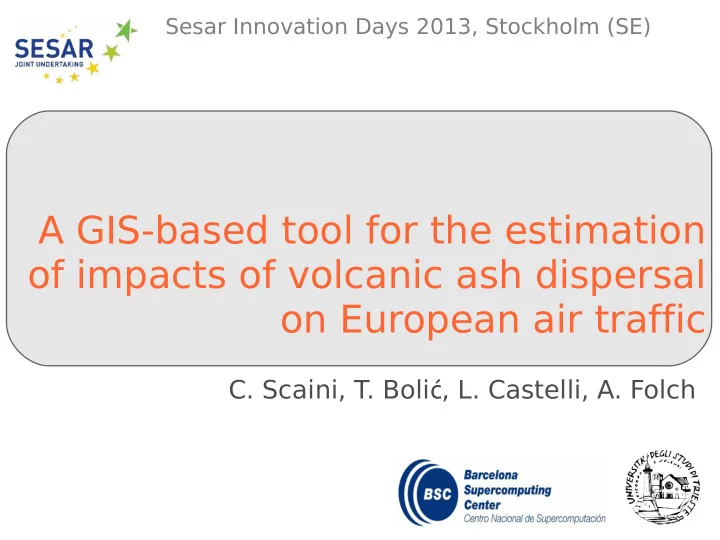

Sesar Innovation Days 2013, Stockholm (SE) A GIS-based tool for the estimation of impacts of volcanic ash dispersal on European air traffic C. Scaini, T. Boli ć , L. Castelli, A. Folch
AFTER 2010... ICAO International Volcanic Ash T ask Force (IVATF) 1st IUGG-WMO Workshop (Bonadonna et al., 2011) … and many more NOW: 2nd IUGG-WMO Workshop (Geneva) Sesar Innovation Days 2013 (Stockholm) OPEN ISSUES (thresholds, graphical output, uncertainty, communication) RESEARCH INTO OPERATION
Monitoring Management @Eurocontrol, many @Volcano observatories others... and many others... Training (VOLCEX) Satellite T ools (EVITA) Ground-based SRA (Safety Risk Assessment) Opportunistic Modeling @VAACS and many others... Different models and strategies
Monitoring Management @Eurocontrol, many @Volcano observatories others... and many others... Training (VOLCEX) Satellite T ools (EVITA) Ground-based SRA (Safety Risk Assessment) Opportunistic LINK modeling Modeling and management @ VAACS and many others... Different models and strategies
HOW? GIS-BASED TOOL Results of ash Air traffic data dispersal modeling Automated GIS-based overlap Expected impacts Where, When, How?
ASH DISPERSAL MODELLING INPUTS : Meteorological (wind speed and direction, humidity, temperature, etc.) Volcanological (column height, duration, grain size, etc.) Calculate ash concentration on a 4-D domain OUTPUTS : Binary files (grib, Netcdf, HDF5) (usually contain a header) Metadata, but no standard/harmonized output
How does a Netcdf look like?
POST -PROCESSING Automated post-processing and production of hourly maps Time step, FL Binary file
CASE-STUDY: Eyjafjallaj ő kull 2010 Numerical simulations performed at BSC (Folch et al. 2011) Ash concentration maps for selected Flight Levels (FLs) Critical ash concentration: zero tolerance, 0.2 and 2 mg/m³
ASH DISPERSAL MODELLING RESUL TS
AIR TRAFFIC DATA European airports and Intra-European routes Use of last filed flight plan ( Source: Eurocontrol DDR m1so6 database) ASSUMPTION: Data for 14/04 can be used to analyze 15-16/04
METHODOLOGY GIS-BASED OVERLAP AT FL TIME STEP = 1 HOUR ASH CLOUD AIR TRAFFIC DATA EXPECTED IMPACTS
Assumptions : Airport disrupted only if overlapped by ash at FL050 Flight disrupted only if intersect ash cloud at FLs Not accounting take-off/landing disruptions All filed flights plans are operating
IMPACT ASSESSMENT - Routes 1- Extract flights (SQL query) at FL interval and time-step 2- Overlap ash cloud and selected flights 3- Extract way-points and segments scheduled at time-step 4- Calculate length of disrupted segments and exposed time
EXAMPLE - Airports For each time step (1 hour) and ash concentration threshold Identify expected disruptions at airports (FL050) Ash cloud
EXAMPLE - Routes Identify routes expected to be disrupted For each time step, FL, ash concentration threshold
IMPACT ASSESSMENT - Routes Qualitative impact rating based on percentage of flight disrupted Comparative (not absolute) measure of impacts Length disrupted x (%) Impact Impact rating Strategy X < 10% Low 1 Small deviation 10% < x < 80% Medium 2 Change FL X > 80% High 3 Not flying
RESUL TS – Hourly tables Impacted flights Expected disruption (length, duration, %) Flight Time tot Length Length Time dis Length Impact ID (min) tot (km) dis (km) (min) dis (%) 135199866 36 251 17 2 7 1 135195266 268 974 1724 47 18 2 135199526 40 425 280 26 66 2 135200495 32.83 247 221 29 89 3 (excerpt of impacted routes for 15 April 2010 - FL150 – 14.00 to 15.00 UTC)
RESUL TS – Time series Impacted flights for each hour at considered FLs FL150 FL200 FL250
RESUL TS – Graphical output Digital maps (GIS) of disrupted airports and flights Visualization of impacted flights Impact assessment rating Advantage : supports further spatial analysis flights Low Medium High
RESUL TS – Google Earth video (screenshot) Advantage: user friendly, easy to share
MAIN FINDINGS Substantial impacts at lower FLs, but low at upper FLs Possible rerouting especially in case of low columns Most affected FLs: 100 ÷ 250 BUT Most congested FLs: 300 ÷ 400
DISCUSSION: Comparison with 2010 shows a reduction of impacted flights BUT: Strong assumptions in methodology (all filed files plans are operating, not considering disruptions due to airport closure) In 2010, precautionary closure of great part of Central European airspace Secondary disruptions (fleet and crew allocation, …) Differences in the expected impacts from those in 2010 (better characterization of input parameters, improved modeling strategies) A direct comparison with 2010 is therefore biased!
FURTHER WORK AND PERSPECTIVES: LIMITATIONS ADVANTAGES IMPROVEMENTS Link modelling and Strong assumptions Economic aspect management Not operational Synthesis Become operational Uncertainties Hourly analysis Include probabilistic forecast Model-independent Include satellite retrievals Lot of work to be done!!! Account for closed airports Spatial and temporal uncertainties Stakeholders feedback – SURVEY to be performed
CONCLUSIONS Improved post-processing of ash dispersal modeling results Automated impact assessment at higher temporal resolution Simplified but multidisciplinary approach improves air traffic management during volcanic eruptions Importance of team-working and diversity
Thank you :) chiara.scaini@bsc.es
Recommend
More recommend